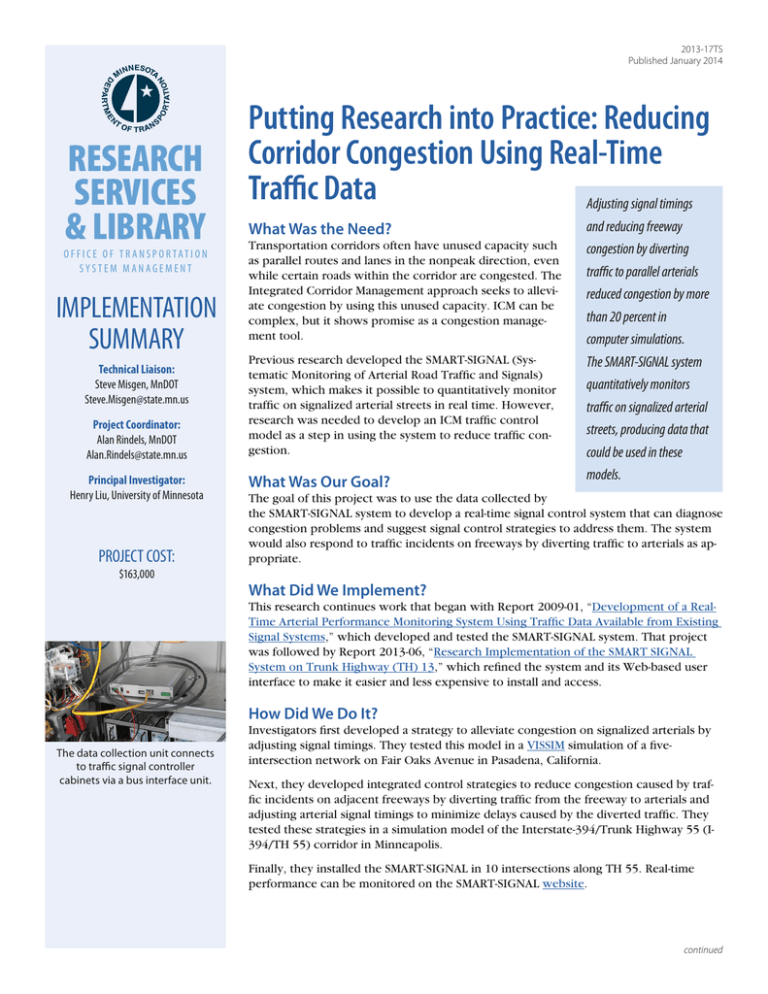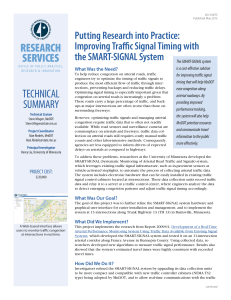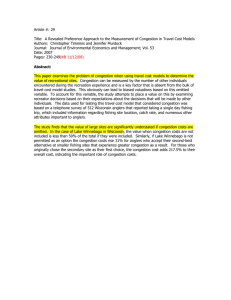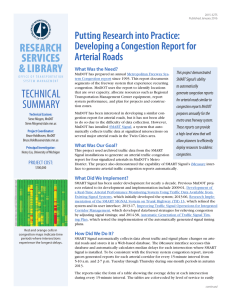RESEARCH SERVICES & LIBRARY Putting Research into Practice: Reducing
advertisement

2013-17TS Published January 2014 RESEARCH SERVICES & LIBRARY O FFI C E O F T R A NSP O R TAT I O N SYSTEM MANAGEMENT IMPLEMENTATION SUMMARY Technical Liaison: Steve Misgen, MnDOT Steve.Misgen@state.mn.us Project Coordinator: Alan Rindels, MnDOT Alan.Rindels@state.mn.us Principal Investigator: Henry Liu, University of Minnesota PROJECT COST: $163,000 Putting Research into Practice: Reducing Corridor Congestion Using Real-Time Traffic Data Adjusting signal timings What Was the Need? Transportation corridors often have unused capacity such as parallel routes and lanes in the nonpeak direction, even while certain roads within the corridor are congested. The Integrated Corridor Management approach seeks to alleviate congestion by using this unused capacity. ICM can be complex, but it shows promise as a congestion management tool. Previous research developed the SMART-SIGNAL (Systematic Monitoring of Arterial Road Traffic and Signals) system, which makes it possible to quantitatively monitor traffic on signalized arterial streets in real time. However, research was needed to develop an ICM traffic control model as a step in using the system to reduce traffic congestion. What Was Our Goal? and reducing freeway congestion by diverting traffic to parallel arterials reduced congestion by more than 20 percent in computer simulations. The SMART-SIGNAL system quantitatively monitors traffic on signalized arterial streets, producing data that could be used in these models. The goal of this project was to use the data collected by the SMART-SIGNAL system to develop a real-time signal control system that can diagnose congestion problems and suggest signal control strategies to address them. The system would also respond to traffic incidents on freeways by diverting traffic to arterials as appropriate. What Did We Implement? This research continues work that began with Report 2009-01, “Development of a RealTime Arterial Performance Monitoring System Using Traffic Data Available from Existing Signal Systems,” which developed and tested the SMART-SIGNAL system. That project was followed by Report 2013-06, “Research Implementation of the SMART SIGNAL System on Trunk Highway (TH) 13,” which refined the system and its Web-based user interface to make it easier and less expensive to install and access. How Did We Do It? The data collection unit connects to traffic signal controller cabinets via a bus interface unit. Investigators first developed a strategy to alleviate congestion on signalized arterials by adjusting signal timings. They tested this model in a VISSIM simulation of a fiveintersection network on Fair Oaks Avenue in Pasadena, California. Next, they developed integrated control strategies to reduce congestion caused by traffic incidents on adjacent freeways by diverting traffic from the freeway to arterials and adjusting arterial signal timings to minimize delays caused by the diverted traffic. They tested these strategies in a simulation model of the Interstate-394/Trunk Highway 55 (I394/TH 55) corridor in Minneapolis. Finally, they installed the SMART-SIGNAL in 10 intersections along TH 55. Real-time performance can be monitored on the SMART-SIGNAL website. continued “Integrated Corridor Management offers a broad operation concept for improving travel efficiency, system reliability and traffic safety for transportation corridors. The approach is considered a promising tool for managing urban traffic congestion.” The SMART-SIGNAL website provides real-time performance data about the I-394/TH 55 corridor as well as several other corridors where the SMART-SIGNAL system is installed. —Henry Liu, What Was the Impact? Associate Professor, University of Minnesota Department of Civil Engineering “Traffic congestion has become an increasingly severe problem for metropolitan areas in the United States and worldwide. Effectively managing traffic during peak hours is a challenging task for investigators and practitioners.” —Steve Misgen, Traffic Engineer, MnDOT Metro District Investigators developed a model for managing oversaturation on signalized arterials based on previously developed oversaturation severity indices. Under this model, several mitigation measures were developed for different types of congestion: • When the green phase of a traffic signal is insufficient to fully discharge the queue, extend the green phase of the signal. • If the queue from a downstream signal spills over to block an upstream intersection, relieve the blockage by extending the red phase at the current light to gate the flow of traffic to remove the downstream spillover. • When both situations occur simultaneously, increase capacity downstream from the intersection by reducing the red phase there. Alternatively, combine the two prior methods by extending both the red and green phases of the light. To optimize traffic flow, investigators developed a two-part procedure. First, red and green times are calculated to eliminate spillover and residual queue along the direction of traffic. Then, working against the direction of traffic, green time changes are made to gate traffic when the first set of calculations are not feasible due to other constraints. The Pasadena simulation demonstrated that this Forward-Backward Procedure is optimal. Relative to actuated-coordinated control with an 80-second cycle, the FBP with an 80-second cycle reduced average delay by 21 percent. With a 120-second cycle, the FBP reduced average delay by 30 percent. The model for diverting traffic between freeways and parallel arterials uses real-time calculations of travel times on both routes and a variable message sign on the freeway to advise drivers of when the arterial route would reduce travel time. The simulation of the I-394/TH 55 corridor showed that this diversion strategy reduced delays after a peakhour traffic incident by 26.13 percent over the base scenario. What’s Next? Produced by CTC & Associates for: Minnesota Department of Transportation Research Services & Library MS 330, First Floor 395 John Ireland Blvd. St. Paul, MN 55155-1899 651-366-3780 www.mndot.gov/research MnDOT has installed SMART-SIGNAL devices at 85 intersections in Minnesota and is currently using the devices for data collection only. Another SMART-SIGNAL project, Automatic Generation of Traffic Signal Timing Plan, will develop algorithms that MnDOT can use to automate signal timing. A second project, Develop Annual Arterial Congestion Report, will track signal performance measures to help prioritize signal retiming projects and produce an annual report similar to one already produced for the Twin Cities area freeways. This Implementation Summary pertains to Report 2013-17, “Improving Traffic Signal Operations for Integrated Corridor Management,” published July 2013. The full report can be accessed at http://www.lrrb.org/PDF/201317.pdf.





